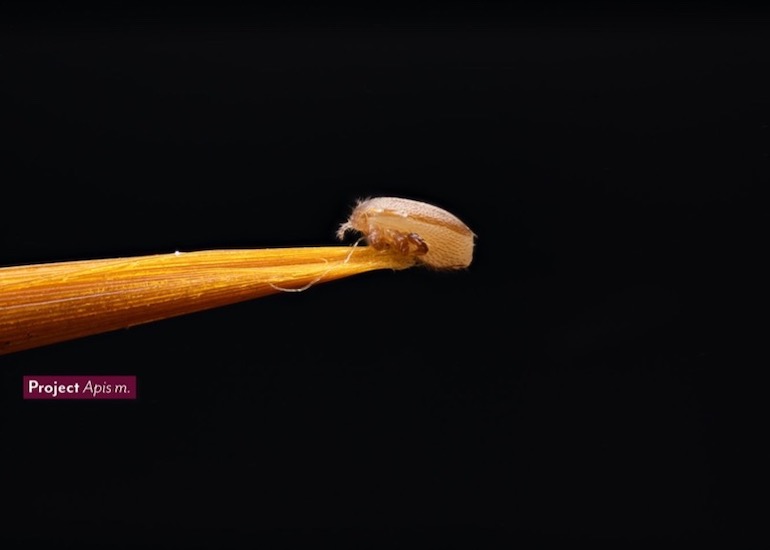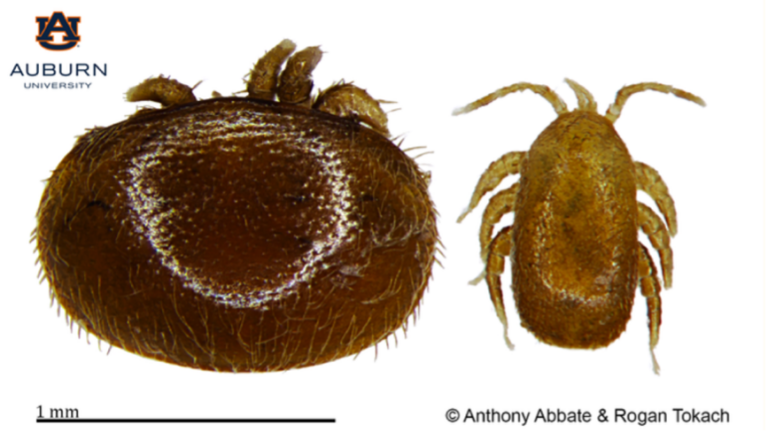Two of our team members, Abderrahim and Joanna, recently attended the COLOSS conference in Wageningen, Netherlands. For those unfamiliar, COLOSS is a global network of researchers collaborating on issues that threaten honey bee health. One topic dominated discussions at the conference: Tropilaelaps.
While our colleagues in the U.S. seem well-acquainted with this pest, many on this side of the pond are less prepared to recognize it, let alone understand its behavior and impact. As Tropilaelaps is expected to become a significant concern in beekeeping, we thought it was the perfect time to introduce this emerging threat and share resources to help you stay ahead. Let’s dive in.
In an alarming development, Tropilaelaps mercedesae has been detected in Western Russia and Georgia, underscoring the growing challenges faced by beekeepers. Historically, Tropilaelaps mites were confined to regions where they co-evolved with Apis dorsata. However, T. mercedesae has now been found parasitizing Apis mellifera, well beyond its native range—a development that raises significant concerns for European beekeepers.
The recent spread into Eastern Europe has drawn attention to this new threat. In 2021, beekeepers in Russia’s Krasnodar and Rostov regions noticed weak colonies and abnormal brood patterns. Genetic analysis of the cytochrome oxidase subunit I (COI) gene confirmed the presence of T. mercedesae. This represents a significant threat, as its proximity to Europe increases the risk of further spread.

Infestations by T. mercedesae have wreaked havoc on honey bee colonies in affected areas. From May 2022 to April 2023, 53% of monitored colonies perished. The remaining colonies were severely weakened, often reduced to just three or four frames of bees. Symptoms included spotty brood patterns, perforated brood cells, and dying workers with elongated proboscises—hallmarks of severe mite infestations.
Interestingly, infestation rates fluctuated with the seasons. Peak infestation, at 75%, occurred in September. By February to mid-April 2023, no mites were detected despite the presence of brood earlier in the year. This seasonal fluctuation suggests that the mites may hibernate within hives or temporarily leave them, making detection and control even more challenging.
While both Varroa and Tropilaelaps mites parasitize honey bees and spread viruses, they differ in several critical ways that impact detection and management:


Forget alcohol washes and sugar shakes—they don’t work for Tropilaelaps. Instead, you’ll need to either uncap brood or check sticky boards. Sticky boards are a good option, but counting Tropilaelaps mites on these boards is far more challenging than with Varroa due to their smaller size and transparency.
A creative detection method gaining traction is ‘brood depilation,’ where wax strips are used to remove cell caps, allowing mites to escape for identification. You can watch a demonstration of this technique here: Brood Depilation for Tropilaelaps Detection.

Since Tropilaelaps mites reproduce within capped brood and feed exclusively on larvae and pupae, effective management begins by interrupting their reproductive cycle. Creating a temporary broodless state in the colony—either by caging the queen or removing the brood—can significantly reduce mite populations.
Some treatments designed to penetrate capped cells have also shown promise in controlling these mites. Existing tools and techniques for managing Varroa mites may be adapted to Tropilaelaps, but ongoing research is expected to refine our understanding and guide the best management practices.
We’ll continue to share updates as more information becomes available on effective strategies for fighting Tropilaelaps.
The spread of Tropilaelaps mercedesae into Europe and potentially beyond presents a serious challenge for beekeepers already managing multiple threats. Proactive measures are needed now to contain the threat and safeguard honey bee populations. Beekeepers, researchers, and policymakers all play a role in raising awareness, monitoring for Tropilaelaps, and developing effective responses.
The good news? Integrated Pest Management (IPM) strategies designed for Varroa can also help manage Tropilaelaps. By combining monitoring, brood management, and effective treatments, beekeepers can tackle both mites simultaneously.
However, education is paramount. Beekeepers must learn to identify Tropilaelaps, understand how to respond to infestations, and apply lessons from our Varroa experience to combat this new threat effectively.
The arrival of Tropilaelaps mercedesae in Europe is a wake-up call for all of us in the beekeeping world. While the emergence of Tropilaelaps may feel like yet another hurdle for beekeepers, we can draw upon the tools and knowledge developed for Varroa management to mitigate this new challenge.
The first step is awareness—knowing what Tropilaelaps mites look like, how they behave, and what to do if they show up in your hives. From there, combining good monitoring practices, brood management, and effective treatments will go a long way in keeping colonies healthy.
It’s not an easy road ahead, but by staying informed and proactive, we can protect our bees and give them the best chance to thrive. We’ve faced tough challenges before, and with continued collaboration and innovation, we can navigate this one too.
References:
 by Véto-pharma
by Véto-pharma  by Véto-pharma
by Véto-pharma  by Caroline Lantuejoul
by Caroline Lantuejoul Join the Véto-pharma community and receive our quarterly newsletter as well as our occasional beekeeping news. You can unsubscribe at any time if our content does not suit you, and your data will never be transferred to a third party!
© 2019-2025, Véto-pharma. All rights reserved